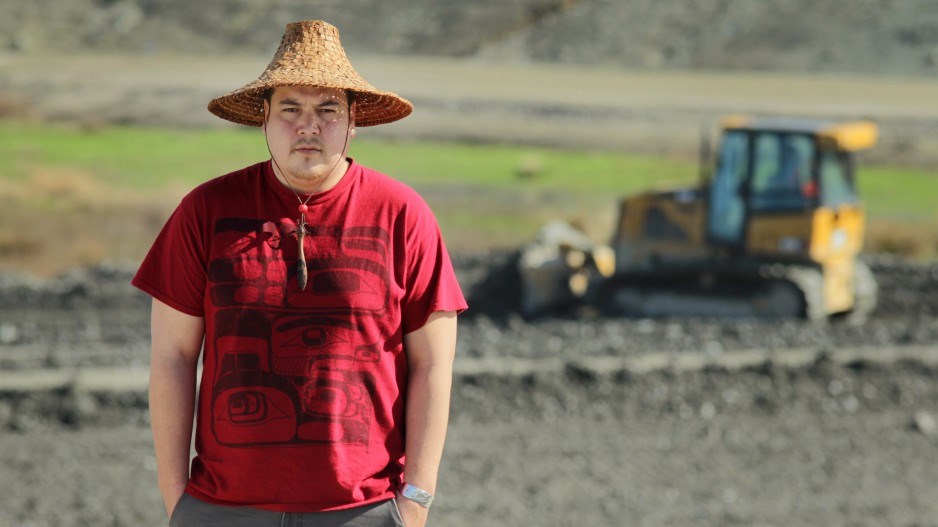Seven years ago, the Tsawwassen First Nation (TFN) became the first aboriginal group in B.C. to implement a modern-day treaty under the B.C. treaty process.
The deal was 23 years in the making. Tsawwassen signed a letter of intent to begin negotiations in 1993, and the treaty was formally implemented in April 2009.
But it’s only been in the last year or two that the treaty’s benefits have begun to bear fruit in a big and very visible way.
A new mall and big-box complex – Tsawwassen Mills and Tsawwassen Commons – are slated to open later this year, approximately 50 new homes have been built, and work is underway on Tsawwassen industrial lands for a new container inspection facility, logistical warehouses and multimodal transloading facilities.
“We think we already have about $1 billion of private-sector investment on Tsawwassen lands, and that number is going to grow,” said TFN government chief administrative officer Tom McCarthy.
As a self-governing First Nation with a 12-member legislature, the TFN operates like a municipal government, but with some additional senior government powers and responsibilities for things like education and municipal services and taxation.
“We have our own tax base that’s currently being built up,” said TFN Chief Bryce Williams. “We started at $600,000 (in 2009-10), and we’re up to just over $5 million this year, and that’s going to continue to grow.
“We have almost full employment for all of our TFN members working on various construction sites and working at the TFN government here.”
The TFN recently opened a new $27 million sewage treatment plant, which is needed to handle all the growth that is expected, including residential development that could see more than 2,000 homes built. It was financed though Vancity, with the loan to be repaid through the lease revenue, taxes and development cost charges the TFN will collect.
Under the treaty, the Tsawwassen (population 480, half of whom live on TFN lands) received $15 million in cash, 1,800 acres of land, hunting, fishing and harvesting rights and a range of self-government powers, including taxation authority.
Tsawwassen treaty lands are strategically located at a transportation intersection that includes the Tsawwassen ferry terminal, the Deltaport container terminal, railway lines and yards and the new South Fraser Perimeter Road. Treaty lands include 330 acres of industrially zoned land and 185 acres of commercial. The Tsawwassen also have the first right of refusal to buy about 600 acres of Crown land at Brunswick Point, which could be added to treaty land.
The TFN attracted two big players in commercial real estate development – Ivanhoé Cambridge, which is building Tsawwassen Mills, and Property Development Group, which is developing Tsawwassen Commons, a big-box complex that will include Canadian Tire, Walmart and Rona outlets. The two projects alone are estimated to represent a $780 million capital investment.
The residential and worker population on Tsawwassen treaty lands is expected to grow, thanks to a 2,000-home residential development, which will mean more local shoppers to support the new shopping centres.
“We see a build-out of the community somewhere in the range of 10 million square feet, with two million square feet of commercial, four million square feet of industrial and about 2,200 to 2,500 homes that could accommodate a population of about 8,000 people,” said Chris Hartman, CEO of the TFN Economic Development Corp.
There are also benefits agreements attached to development projects that guarantee jobs and business opportunities for Tsawwassen members.
As for the industrial land, work is underway on new logistics and warehousing facilities, including:
•11.5 acres leased to Port Metro Vancouver for a new 110,000-square-foot container inspection facility that will be used by Canada Border Services Agency;
•57 acres leased to Great-West Life for a 1.3-million-square-foot logistics warehousing facility; and
•23.5 acres to Euro Asia for a new transloading facility for moving goods to and from truck or rail to shipping containers.
There is also a new Chevron Canada diesel cardlock fuel station to serve the trucking industry.
The TFN will be generating revenue from the various development projects through property taxes, development cost charges and lease revenue.
Starting next year, the TFN government will begin collecting PST and GST. It will receive a portion of those taxes. The balance will go to the provincial and federal governments. In 2022, TFN members will be required to pay income and property taxes.
Not all B.C. First Nations feel the B.C. treaty process is the best way to settle land claims and achieve self-government. The Tsilhqot’in, for example, fought a long and costly court battle that awarded the band title to 1,750 square kilometres of Crown land. But numerous self-government issues will still need to be negotiated with senior governments.
Kim Baird, who was chief during much of the Tsawwassen treaty negotiation process, said the treaty gives her people a degree of self-determination that just doesn’t come with land alone.
“The mall project could not have happened on Tsawwassen land had it been under the [federal] Indian Act system,” she said.
“From my perspective, what we’re trying to achieve is socio-economic parity, and we’re … trying to see if the gaps in the education levels and income levels and all those things will close over time, which I’m pretty sure they will. And that has a lot to do with the jurisdiction we now have.”




